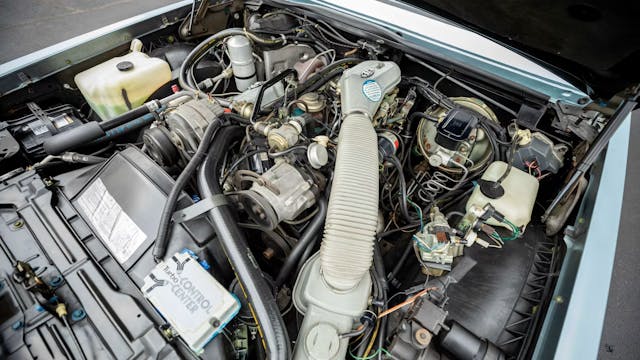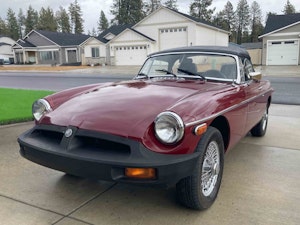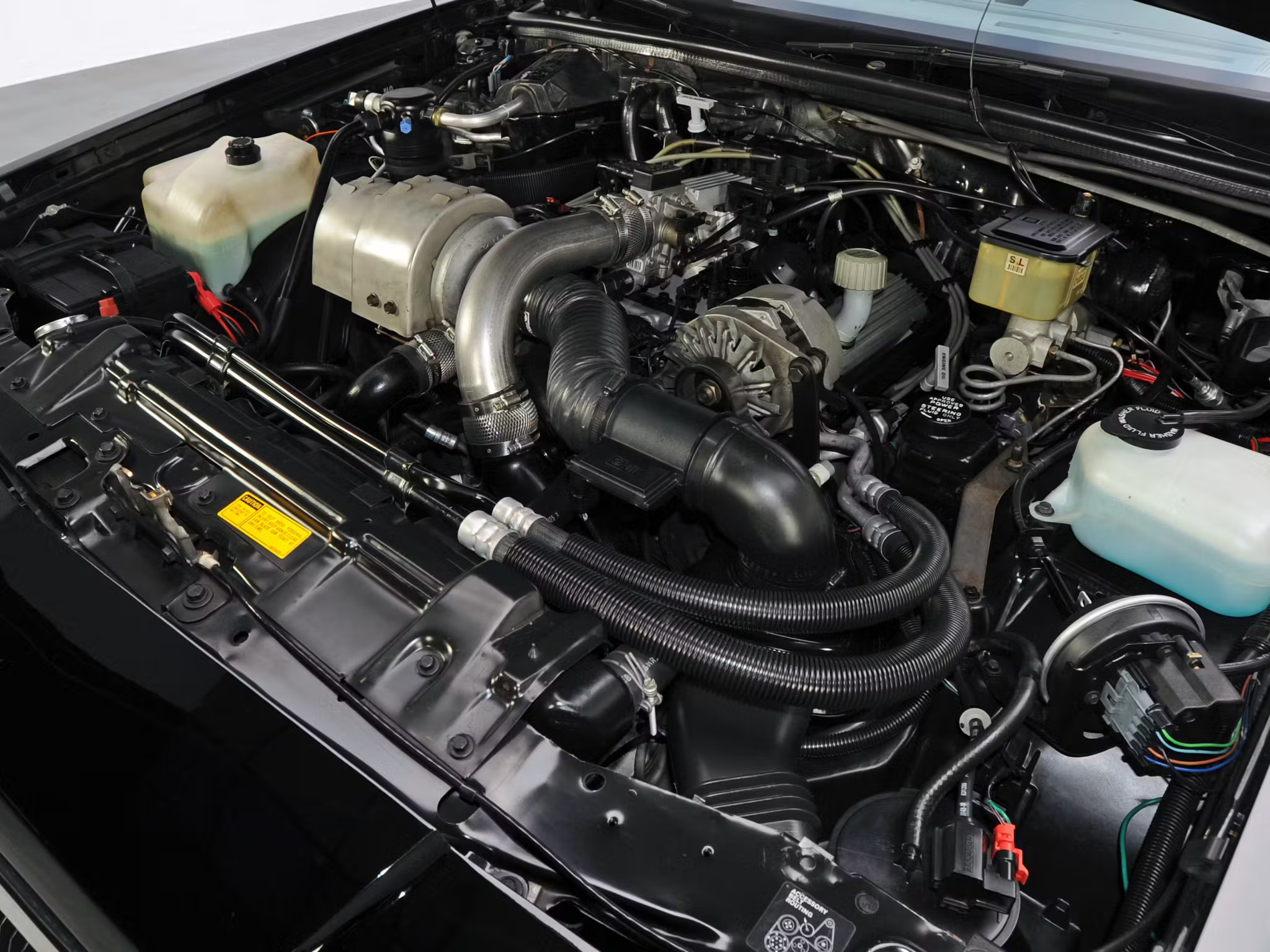Media | Articles
GM’s 3800 V-6 was long-lived and underappreciated
The Chevy small-block V-8 is perhaps the most famous engine ever produced by General Motors. It is a simple, stalwart design whose popularity and status only cemented as it became the powerplant of choice among hot-rodders. For more than 50 years, the small-block has been the backbone of affordable speed. However, just as significant in GM history is an engine that toiled (albeit less prominently) for nearly as long: the 3800 V-6.
Between its 1975 debut and its 2008 sunset, this 3.8-liter V-6 was installed under the hood of more than 25 million vehicles. Originally designed by Buick, it was mostly assigned to workhorse duty for Oldsmobile, Pontiac, and Buick, motivating fleets of sensible sedans and coupes. While the 3800 did enjoy a few flashes of auto enthusiast attention, it never got the same widespread adulation as the small-block or even the big-block, and many assign it second-tier status among engines in GM’s historic portfolio.
Here’s the story of how a derivative, near-castoff engine design came to be critical in fueling the fortunes of America’s largest car company.
Aluminum bad, iron good (but rough)
The 3800’s origins date back to the early 1960s, when Buick debuted the first V-6 passenger car engine ever to be manufactured in the United States. A byproduct of the company’s quest to produce its own unique, aluminum-block V-8 (marketed as the Fireball), the cast-iron V-6 Fireball was far easier and significantly cheaper to build. This being a mass-market powerplant, it also helped that the V-6 version did not suffer the high rate of defects associated with the V-8’s aluminum construction.
Unfortunately, despite the benefits of its relatively light weight, the Fireball V-6 retained several design elements from the V-8 that, initially, proved sub-par in translation. As a cost-cutting measure, GM effectively sliced a pair of cylinders from the end of the original engine while retaining the 90-degree bank angle. Though the V-8 enjoyed the balance of an even firing interval, the V-6 version had an odd firing interval that gave these early 3.2-liters a rough, rumbly idle.
Marketplace
Buy and sell classics with confidence

Even with softer, flexible motor mounts to absorb vibrations, it won few fans. The V-6 floated through the small and “intermediate” Buick and Oldsmobile line-ups between 1962 and 1967, and even a displacement boost couldn’t convince GM execs to stay the course.
Instead of reengineering the V-6 at great cost, perhaps with a balance shaft, Buick made a shrewder move: it offloaded the Fireball V-6 tooling to Kaiser-Jeep, which had no qualms about stuffing a less-than-smooth motivator into its Jeeps and other rustic SUVs. Fortunately, a third-act mea culpa forced by the OPEC energy crisis saw GM buy back the rights to its own engine design from a cash-starved AMC in 1974, after realizing its fuel-efficient cupboards had run largely bare.
It’s here that the 3800 series found its true beginning.
Will the real V-6 please stand up?

Always cost-conscious, GM had first tried to sweet-talk AMC into handling manufacturing the overhead-valve V-6 engine. After being rebuffed (or repulsed by a desperate American Motors quoting an exceptionally high price tag for production, depending on which story you believe), GM changed tack. It took a quick and easy route to push the V-6 to the market for 1975, punching displacement out to its final 3.8-liter form—in its own factory—but leaving everything else about the motor unchanged.
The 3.8-liter V-6 saturated GM showrooms almost immediately, powering models as diverse as the Chevrolet El Camino, the Pontiac LeMans, and the Buick Skyhawk, with stops in the Oldsmobile Cutlass and the Pontiac Firebird along the way. With close to 20 different models laying claim to the V-6, economies of scale were such that Buick’s once-cast-off engine finally warranted the refinement and development it had previously been denied a decade before. This primarily took the form of a split-pin crankshaft that revised the engine with an even-firing pattern, effectively erasing the previous, unpleasant vibrations.
This one simple decision, arriving in 1977, helped cement the engine as the bedrock of the General Motors passenger car. However, despite its status as an affordable powerplant (true for both manufacturers and buyers), the V-6 was about to pull a power move seldom seen in the automotive world: The humble 3.8 made a play for enthusiasts’ hearts with a red-hot high-performance edition.
Soaring fuel prices and crushing emissions regulations, you may recall, had sidelined large-displacement V-8 engines for much of the 1970s. That caused automakers far and wide to search for alternatives to big cubic inches. Buick had been toying with turbocharging for several years prior to the 1978 launch of its T-Type family, and boosted versions of the V-6 ultimately covered almost every two-door car built by the brand. The setup even branched out into motivating the Pontiac Trans Am Turbo and Chevrolet Monte Carlo Turbo. Forced induction proved an unexpected edge for GM as it moved into the ’80s, culminating in the era-defining Regal Grand National and GNX models. These legendary eight-cylinder-slayers owe their success to the might of GM’s turbo 3.8-liter V-6 engines.
Front-wheel drive future

While the rear-drive Grand National and its longitudinal engine may have garnered the most headlines, it was the transverse version of the 3.8-liter V-6 that had the broadest influence in the industry. General Motors was knee-deep in its transition to front-wheel drive platforms by the middle of the 1980s, and it massaged and modified the 3.8 to meet this new challenge. In the space of a few short years, the engine abandoned carburetors for electronic fuel injection, lost its traditional ignition distributor, and gained a balance shaft—moves that thoroughly modernized the V-6 to match the expectations generated by the rising tide of competing Japanese imports.
By 1988, the 3800 moniker became official. It was applied to a fresh crop of 3.8-liter engines that embodied the sweeping updates making so-equipped GM cars competitive with Ford, Toyota, and Honda. Dubbed the “Series I,” the engine was initially assigned to the mid-size and full-size sedans and coupes first to heed GM’s front-wheel drive call. It wasn’t long, though, before the transverse 3800 had spread into nearly every corner of the Buick, Chevrolet, Pontiac, and Oldsmobile empire.
Once again the bread and butter of General Motors’ engine strategy, the 3800 was once again courting forced induction at the start of the 1990s. This time it was a supercharger (rather than a turbo) stuffing additional atmospheres into the combustion chamber, and a blower first found its way into big-boned Buicks via the Park Avenue and its Oldsmobile and Pontiac equivalents.
Stay of execution

One more major metamorphosis awaited the 3800, this one nearly 35 years after its initial Fireball debut. Dubbed the “Series II,” this V-6 variation represented the culmination of GM’s engine design prowess at the time. It arrived in 1995 with cross-bolt main bearing caps, bigger valves nestled inside larger cylinder heads, the highest compression ratio to date, and a composite intake manifold, among many other internal and external improvements (including a lower deck height that helped with packaging and reduced weight). Also along for the ride was an improved, Eaton-supercharged edition of the engine that became nearly as common as the naturally aspirated version. The 3800’s dominance of General Motors drivetrains was nearly impossible to escape in any sedan or coupe car larger than compact-size.

The 3.8-liter V-6 was well-positioned to ride out the rest of the decade in style. While it received a Series III update for 2004 (including throttle-by-wire and a new fuel injection system, along with an aluminum intake manifold to replace the previous plastic unit), the fundamentals remained the same until it was pulled from production in 2008. By that point, the 3800 had far outlived its planned obsolescence, arguably by almost a decade—proof of what its diehard reliability and appealing low cost meant to GM’s bottom line.
An ode to endurance
Time has caught up to nearly every pushrod engine. While the LS-series of small-block Chevrolet V-8s continues to generate massive profits in the pickup and SUV market, General Motors eventually yielded to the efficiency benefits and sophistication of dual overhead camshafts in its passenger cars. The relatively large displacement of the 3800 in this context—slightly greater than the company’s current range-topping 3.6-liter V-6—didn’t make it an appealing do-it-all base engine in a world where turbocharged four-cylinders dominate.
Still, the endurance and relevance of the 3800 is astounding. Even at the end of its lifespan, in terms of weight the iron-block engine was within spitting distance of the aluminum block V-6 that replaced it, and its horsepower, torque, emissions, and fuel efficiency remained competitive until its final hour. What began as a decidedly simple, budget-driven afterthought evolved over several decades into a decidedly unsexy yet remarkably effective multi-purpose tool. It plugged nearly every hole in the GM line-up for decades. Following initial bumps, GM committed to continual improvement and modernization that extracted an absurd tour of duty from an engine that was, at the outset, dumped on a rival’s doorstep.
***
Check out the Hagerty Media homepage so you don’t miss a single story, or better yet, bookmark it. To get our best stories delivered right to your inbox, subscribe to our newsletters.














Riviera Supercharged, fast and comfy. Cruise at 85 all day long!! should have kept it!!!
My memory of the 3.8 Buick is decidedly different. Between about 1978 and 1983 this engine existed in two forms, those that ate their crank shaft bearing and those that were going to. So much so that late model salvage yards in my area could not supply the demand for engines with hot idle speed oil pressure over 8 to 10 psi,. I replaced just over 100 engines in a 4 year span, mostly in Buick and Oldsmobiles. The newest had just over 8000 miles, the rest failed by 35,000. It appeared the align bore was off, Judging by the random locations of the worn out bearing inserts. Nearly always the mains. Four salvage yards in the northeast Ohio area had waiting lists for good engines. I made a lot of cars with flickering oil lights trade-in worthy by removing the oil pressure bulb or installing 15w40 marine engine oil. I learned early to decline crank replacement jobs as it was expensive and got a few thousand more miles out of 20 to 30,000 mile engines. To my knowledge, GM never issued a recall for this quality failure. I read later that AMC machined or assembled a large percentage of the 3.8’s in these years. If this is true, perhaps the defects originated in that decision. I never saw a similar bearing failure in any of the higher performance versions with turbos.
The series 2 and 3 supercharged engines are the best and easist upgrade for any Fiero. They make them a true sportscar. Also the 4t65Ehd transmission with them gives unbelievable performance and mileage!!
First new car we bought was a 1976 Pontiac Sunbird sedan. 3.8 l with a 5 speed manual. Kept it for 17 years, one carb kit was the only engine work. Very fast and great on gas. Wish I still had the engine and transmission for a project I would like to do.
Poor memory, 1979 not 76
Lived through the entire thing while running my auto shop. 2-3 different intake gasket sets on the early odd fires. It was crazy, but also quite as easy to service as it was a Buick 350… minus 2 cyls. The last gen 3800’s wete also some of the smoothest V6 motors that GM ever made.
what a great little engine, I bought one in 1984 when the fuel injected turbo grand nationals came out, I worked at O’Hare and lived in a small town in Wisconsin on the border, tripping back and forth was 100 miles, just about every day someone wanted me to a race them on route 12, most of the time I won, as time went by I noticed this engine never used a drop of oil and at 200 thousand miles it still had good compression, that’s when I decided to use the same engine in a street rod I was building, I found a wrecked 85 GN and bought it for the engine and trans, I pulled the engine apart and rebuilt it, porting and polished the heads, port matched the intake and exhaust, installed an Ersen cam, Kenny Bell headers, bigger injectors, had the reciprocating mass balanced, the car it’s in is a chopped 1934 Oldsmobile, it weighs 29 hundred pounds and it’s really fast, there great engines that make as much horsepower as most V8s and only weigh 375 pounds, I’ve got another turbo V6 and looking for something cool to put it in.
My wife and I had a clean, heavily optioned, used 90 Buick LeSaber with the series1 3800 in it and it was a beast!! Change the oil regularly, and do routine maintenance and it was built proof. It was a tolerable engine to work on too. Its components were easy to replace as long as you knew what to diagnose and what you were doing. We drove that car for almost two decades! The engine was still going strong, with very high mileage but the body just couldn’t hold up. I did my best to keep it on the road for as long as I could. Even spray caned two-toned it to cover the delaminating paint on the hood, roof, and deck lid. Eventually the shock towers, both front and rear, frame rails, suspension parts, brake and fuel lines all succumbed to rust from many, many years of service. It was a sad day when we had to give it up. It was one of the best cars we’ve owned. It was a reliable engine in a great car!:))
I had one of these engines in my 1990 Holden & it was noisy & unreliable. I had it for 4 year & all in all was a horrible experience. Couldn’t wait to get rid of it to buy a Ford. I didn’t buy another Holden till 2009 when i got a V8 Holden SS.
The 3.8 is a great motor, had it in 3 LaSabres and a Bonneville. Currently use two LaSabres, 2001 & 2004 as daily commuters for my Wife and I. The 2004 has 340K miles on it and still going strong. Sure each has little thing that go wrong, but commuting 140 miles per day, the great comfort, quietness, driving, gas mileage, 30 – 32 mph on the road, low taxes and insurance, its a no brainer. Give it a little TLC and it will treat you right. With good snow tires, and a block heater, it will handle snow and ice much better than my Tahoe or 4 wheel drive pickup. Keep the snow under a foot and traction control off in deep snow (got to keep the tires turning and digging), they are a winter driving machine. Battery under the back seat was not one of Buick’s better idea, the 3.8 is.
I owned a couple of cars with the 3800, all of which outlived the car. Unlike the younger 3.6L that GM is installing in cars now. There are rumors the real reason why the 3800 was retired was it was too reliable.
Has everyone (including author Hunting) forgotten the Buick V-6’s impressive motorsports career? Besides sitting (in stock-block, turbocharged form) on the pole at Indy, various versions of it excelled in junior series Indy Lights and road racing Camel Lights and dominated then-V-6-powered tier 2 NASCAR competition for many years, not to mention substantial NHRA success: https://www.hagerty.com/media/automotive-history/buick-racings-forgotten-v-6-juggernaut/
Still have a Pontic Bonneville SSE with 440000 miles on engine and original transmission well taken care of I mechanic on it my self .just replaced the AC system only problem is temp door control doesn’t work have to do manually not easy to get to .Low oil pressure after someone els worked on it unfortunately.
Now I have never owned a GM car, but worked in mass mkt. dealers and retail auto shops for about 7 years. Many mid 90’s -2000’s Buicks with the 3800 still crawl the roadways. The trans usually lunch close to 100k but the motor soldiers on! My wife and I call them “ubiquibuicks” because of their prolific nature. My late brother n law had two that he drove into submission with over 200k each- his final vehicle 2000 something Caddie was a real POS. He fondly spoke of his Buicks
Owned two supercharged Bonnevile SSEis; a 94 and a 98. Lot of tech, lots of fun, but lots of repairs too ( the 98 went through FOUR alternators). My buddy bought a grand national new but wasn’t satisfied. He bought a GNX about a year later…
I humbly admit that I’ve built dozens+ of the Buick 3.8L engines during my career. It is a Stellar platform. And the Grand National is testament to its 💪🏻 strength.
The 3800 nestles comfortably between the SB/BB dynasty and the current LS reign of custom installs. JMHO👌